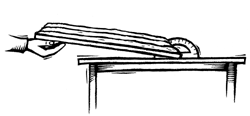Avalanche!
|  |
Student Handout |
Slip Sliding Away
As a snowpack forms over several days, weeks, or months, layers of snow are
deposited one onto another. The kind of snow, the incline of the slope, and the
terrain all play a role in when and where avalanches will occur. In this
activity, you will model how a snowpack might form over several months and then
cause your own avalanches.
Part I
When examining the foam board, predict how you would expect "snow" to behave
on each of the four surfaces: acetate, plain foam board, burlap, and rocky.
On which surface(s) would you expect to see snow slide at a low incline? On
which surface(s) would you expect snow to slide at a moderate or high incline?
Why? Spread newspapers under your Foam Board Model before you begin creating your
snowpack. Now start laying down your first winter snowfall. Early on in the
season light snow will cover the area. To model this, shake a coating of
granulated sugar over the entire surface. Next, winter storms dump lots of heavy snow on the mountainside. Then wind
blows the snow around, breaking it into smaller crystals and depositing a dense
layer. To simulate this, cover the granulated sugar layer with half your amount
of flour. Pat down the flour and even out the surface. A long cold spell comes along. More light snow falls onto the hillside. Model
this with the potato flakes, evenly distributing a light layer on top of the
flour. Finally, another huge winter storm hits, followed by more wind. Simulate this
by using the remaining amount of flour to cover the potato flakes layer. When
you are finished, pat down the flour and even out the surface.
Part II
Now you are ready to simulate your avalanche. Place additional newspaper near
the board to catch the sliding snow. Before inclining the board:

You will need to measure the angle at which the avalanche begins. To do so, have one
member of your team line up the protractor with the edge of the board to record the angle of
incline. When the board is inclined, another team member will read numbers off the protractor. You will need to have team members choose which areas each will watch for cracks and snow
releases in the snowpack. If you incline the board too quickly, you may miss several smaller
avalanches and will have missed data to collect.
Slowly incline the board. As the incline increases, record your
observations and complete the chart below for each snow release.
Surface and degree
of incline at which
snow slid
|
Description
of
avalanche
|
Why
snowpack
slid
|
for example:

|

|

|
|
|
|
|
|
|
|
|
|
Questions
Write your answers on a separate sheet of paper.
For each section, at what angle did the snow begin to slide? In nature,
avalanches are most common at slopes of 35 to 40 degrees. Why might it be
unlikely for snow to avalanche on very steep or very gentle slopes? How did the rocks on the slopes affect the avalanches? Why? For each section, did all of the layers in the snowpack slide at the same
time or separately? Describe how the surface upon which the snowpack rested
affected the way layers slid. Based on this model, what generalizations might you make about how slope,
terrain, and layers within the snowpack affect avalanches that occur in
nature?
|